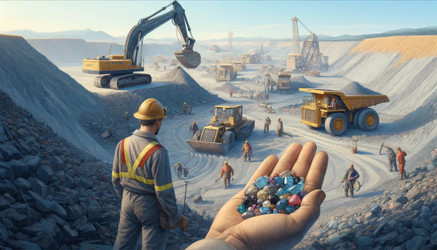Discovering the Origins of Zircon: A Gemstone's Journey
Posted by Zircon Jewelry on Apr 15, 2024
Zircon, not to be confused with synthetic cubic zirconia, is a natural gemstone admired for its dazzling optical properties and array of colors. From the depths of ancient rocks to the sparkling adornment in jewelry, zircon has a fascinating story that spans across continents and geological periods. This blog post delves into the origins and global locations of zircon mining, emphasizing its geological and aesthetic value.
Where is Zircon Found?
Zircon stones are sourced from diverse geological settings around the world. The extraction of this gemstone primarily occurs in sedimentary deposits, igneous rocks, and metamorphic formations. Here are key regions that are prolific producers of zircon:
- Australia: As one of the world's leading producers, Australia boasts significant zircon deposits. Areas like the Murray Basin and the coasts of Western Australia and Northern Territory are rich in mineral sands that contain zircon.
- Africa: The African continent is another hotspot for zircon mining, particularly in countries such as South Africa, Mozambique, and Madagascar. These regions typically exploit the vast beach sands, which are home to heavy minerals including zircon.
- Asia: Sri Lanka is famous for its high-quality gem zircons, often used in exquisite jewelry. Other notable Asian sources include Cambodia, Myanmar (formerly Burma), and Vietnam, each contributing to the global supply of this versatile mineral.
- United States: In North America, states like Georgia and Florida have deposits of zircon in heavy mineral sands. These are mined for both gem-quality stones and industrial applications.
Zircon's Geological and Market Value
Zircon's age can reach over 4 billion years, making it one of the oldest minerals on Earth. Its high refractive index and strong dispersion make it a popular choice among gem enthusiasts who appreciate its likeness to diamond. However, what sets zircon apart is not just its beauty but its thermal and chemical durability, which makes it a valuable resource in various industrial sectors.
Mining and Environmental Impact
Mining for zircon involves techniques like dredging and open-pit mining. These methods, while effective, often raise environmental concerns such as habitat disruption and water contamination. It is crucial for mining operations to adhere to sustainable practices to minimize environmental impact and ensure the longevity of zircon supplies.
Conclusion
Zircon’s journey from a buried gemstone to a cherished piece of jewelry is as remarkable as the stone itself. With deposits scattered across the globe, zircon continues to be a gemstone of choice for its beauty and versatility. Whether it is set in a ring or used in manufacturing, zircon remains a testament to the Earth’s geological marvels.
Keywords: Zircon mining, gemstone origins, Australia zircon, Africa zircon, Asia zircon, USA zircon, sustainable mining, mineral sands, geological deposits, gem-quality zircon.
This blog post serves as a comprehensive guide to understanding where zircon comes from and the importance of sustainable practices in its extraction. Whether you are a gem collector or someone interested in the environmental aspects of mining, zircon’s story is sure to captivate.


